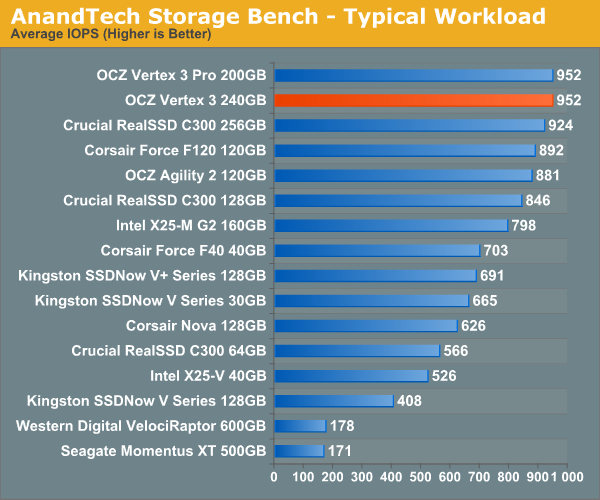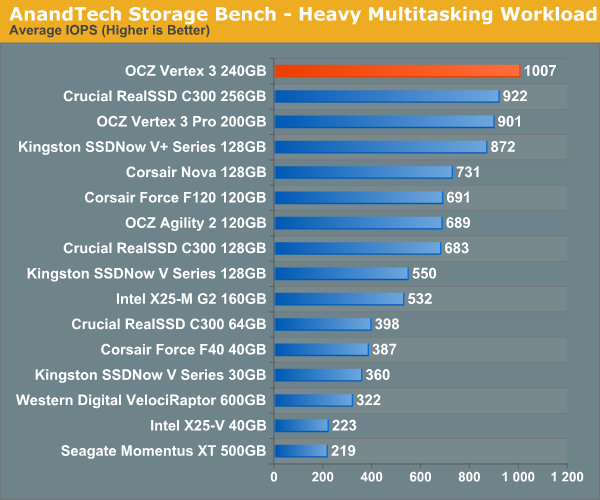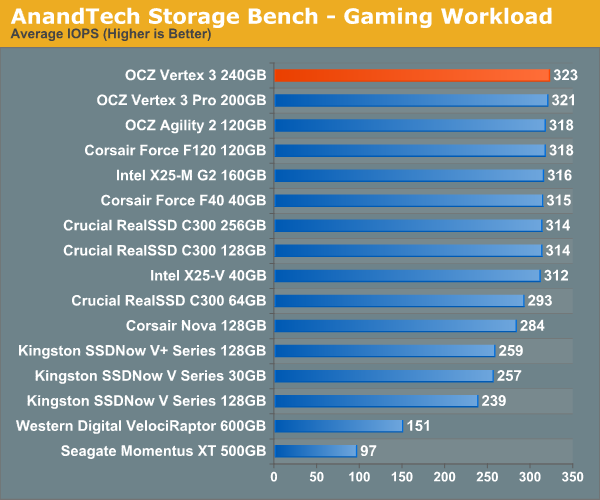OCZ Vertex 3 Preview: Faster and Cheaper than the Vertex 3 Pro
by Anand Lal Shimpi on February 24, 2011 9:02 AM ESTAnandTech Storage Bench 2010
To keep things consistent we've also included our older Storage Bench. Note that the old storage test system doesn't have a SATA 6Gbps controller, so we only have one result for the 6Gbps drives.
The first in our benchmark suite is a light/typical usage case. The Windows 7 system is loaded with Firefox, Office 2007 and Adobe Reader among other applications. With Firefox we browse web pages like Facebook, AnandTech, Digg and other sites. Outlook is also running and we use it to check emails, create and send a message with a PDF attachment. Adobe Reader is used to view some PDFs. Excel 2007 is used to create a spreadsheet, graphs and save the document. The same goes for Word 2007. We open and step through a presentation in PowerPoint 2007 received as an email attachment before saving it to the desktop. Finally we watch a bit of a Firefly episode in Windows Media Player 11.
There’s some level of multitasking going on here but it’s not unreasonable by any means. Generally the application tasks proceed linearly, with the exception of things like web browsing which may happen in between one of the other tasks.
The recording is played back on all of our drives here today. Remember that we’re isolating disk performance, all we’re doing is playing back every single disk access that happened in that ~5 minute period of usage. The light workload is composed of 37,501 reads and 20,268 writes. Over 30% of the IOs are 4KB, 11% are 16KB, 22% are 32KB and approximately 13% are 64KB in size. Less than 30% of the operations are absolutely sequential in nature. Average queue depth is 6.09 IOs.
The performance results are reported in average I/O Operations per Second (IOPS):

If there’s a light usage case there’s bound to be a heavy one. In this test we have Microsoft Security Essentials running in the background with real time virus scanning enabled. We also perform a quick scan in the middle of the test. Firefox, Outlook, Excel, Word and Powerpoint are all used the same as they were in the light test. We add Photoshop CS4 to the mix, opening a bunch of 12MP images, editing them, then saving them as highly compressed JPGs for web publishing. Windows 7’s picture viewer is used to view a bunch of pictures on the hard drive. We use 7-zip to create and extract .7z archives. Downloading is also prominently featured in our heavy test; we download large files from the Internet during portions of the benchmark, as well as use uTorrent to grab a couple of torrents. Some of the applications in use are installed during the benchmark, Windows updates are also installed. Towards the end of the test we launch World of Warcraft, play for a few minutes, then delete the folder. This test also takes into account all of the disk accesses that happen while the OS is booting.
The benchmark is 22 minutes long and it consists of 128,895 read operations and 72,411 write operations. Roughly 44% of all IOs were sequential. Approximately 30% of all accesses were 4KB in size, 12% were 16KB in size, 14% were 32KB and 20% were 64KB. Average queue depth was 3.59.

The gaming workload is made up of 75,206 read operations and only 4,592 write operations. Only 20% of the accesses are 4KB in size, nearly 40% are 64KB and 20% are 32KB. A whopping 69% of the IOs are sequential, meaning this is predominantly a sequential read benchmark. The average queue depth is 7.76 IOs.











85 Comments
View All Comments
FunBunny2 - Thursday, February 24, 2011 - link
Well, no custom firmware, just a custom controller. Intel had the first really good pro-sumer controller. Likely still does.bhougha10 - Thursday, February 24, 2011 - link
Anand,can you give us an idea when the intel G3 will be comming out so we have an idea wait the field looks like here. Intel seems to keep this stuff very secret :(
mckirkus - Thursday, February 24, 2011 - link
510 Series from Intel launching March 1 if you believe the rumors. Sata 6Gb/s but using 34nm flash. Just over $2/GB. Seems like it has low IOPS compared to other SSDs but real world performance is TBD.I'd bet a dollar Anand is working on a review of one right now. I'm using a 1st gen Sandforce drive and it's so damn fast I'm not sure I'll ever need to upgrade the thing.
iwod - Friday, February 25, 2011 - link
Not a Rumors, someone from Taiwan already has their hands on it.It uses an Marvel Chipset.
At this moment we are still not sure if 510 series means G3.
JonnyBlaze - Thursday, February 24, 2011 - link
Not a bad idea.lorteti - Thursday, February 24, 2011 - link
Hi Anand,How about a power consumption test.
For those that want to use the Vertex3 in a notebook.
Thanks,
jx
JFish222 - Sunday, February 27, 2011 - link
Hi Anand,I'd like to second this request.
I'd love to throw one of these into my laptop, but I'm always looking to balance performance with battery life (the old T61 is getting long in the tooth and an SSD sounds like a perfect upgrade!)
All of the recommendations to add SSD's to "netbook class units" (atom and Brazos) adds to this conversation. Though netbooks are popular due to their low price, their portability and battery life (which one could argue are one and the same) are also selling points.
Thanks again for the great review, and I'm looking forward to your future investigations into the OCZ debacle. Journalism has always been about both informing and inciting change. Anandtech remains the only site on the net that I've found that has the reach to do both.
Thanks again,
Jordan
MarcHFR - Thursday, February 24, 2011 - link
Dear all, Dear Anand,I think it's important to note that AnandTech Storage Bench, like PC Mark Vantage HDD, represent a "best case" for SandForce based SSD.
These benchmarks are based on logs which have recorded accesses to be repeated, but not the data contained in these accesses. These means that the data used in the benchmark may well be highly compressible, which isn’t necessarily the case in real usage.
Am i wrong ?
Chloiber - Thursday, February 24, 2011 - link
I wanted to ask the same thing in the Vertex 3 Pro test. Would be nice to have an answer here. I don't think that the data is random.jwilliams4200 - Thursday, February 24, 2011 - link
I've also wondered about that. Does the 2011 Storage Bench that writes 100+ GB of data have a 100+ GB data file? If so, how much does that data file compress when run through a zip or 7zip compression program?If not, if the data file is much smaller than 100 GB, then exactly what is being written to the drives?